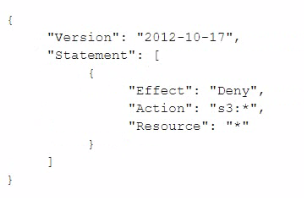Most Recent Amazon SCS-C02 Exam Dumps
Prepare for the Amazon AWS Certified Security - Specialty exam with our extensive collection of questions and answers. These practice Q&A are updated according to the latest syllabus, providing you with the tools needed to review and test your knowledge.
QA4Exam focus on the latest syllabus and exam objectives, our practice Q&A are designed to help you identify key topics and solidify your understanding. By focusing on the core curriculum, These Questions & Answers helps you cover all the essential topics, ensuring you're well-prepared for every section of the exam. Each question comes with a detailed explanation, offering valuable insights and helping you to learn from your mistakes. Whether you're looking to assess your progress or dive deeper into complex topics, our updated Q&A will provide the support you need to confidently approach the Amazon SCS-C02 exam and achieve success.
The questions for SCS-C02 were last updated on May 7, 2025.
- Viewing page 1 out of 74 pages.
- Viewing questions 1-5 out of 372 questions
A website currently runs on Amazon EC2, wan mostly statics content on the site. Recently the site was subjected to a DDoS attack a security engineer was (asked was redesigning the edge security to help
Mitigate this risk in the future.
What are some ways the engineer could achieve this (Select THREE)?
To redesign the edge security to help mitigate the DDoS attack risk in the future, the engineer could do the following:
Move the static content to Amazon S3, and front this with an Amazon CloudFront distribution. This allows the engineer to use a global content delivery network that can cache static content at edge locations and reduce the load on the origin servers.
Use AWS WAF security rules to inspect the inbound traffic. This allows the engineer to use web application firewall rules that can filter malicious requests based on IP addresses, headers, body, or URI strings, and block them before they reach the web servers.
Use Amazon Route 53 to distribute traffic. This allows the engineer to use a scalable and highly available DNS service that can route traffic based on different policies, such as latency, geolocation, or health checks.
An IAM user receives an Access Denied message when the user attempts to access objects in an Amazon S3 bucket. The user and the S3 bucket are in the same AWS account. The S3 bucket is configured to use server-side encryption with AWS KMS keys (SSE-KMS) to encrypt all of its objects at rest by using a customer managed key from the same AWS account. The S3 bucket has no bucket policy defined. The IAM user has been granted permissions through an IAM policy that allows the kms:Decrypt permission to the customer managed key. The IAM policy also allows the s3:List* and s3:Get* permissions for the S3 bucket and its objects.
Which of the following is a possible reason that the IAM user cannot access the objects in the S3 bucket?
The possible reason that the IAM user cannot access the objects in the S3 bucket is D. The KMS key policy has been edited to remove the ability for the AWS account to have full access to the key.
The other options are incorrect because:
A developer signed in to a new account within an IAM Organization organizational unit (OU) containing multiple accounts. Access to the Amazon $3 service is restricted with the following SCP.

How can the security engineer provide the developer with Amazon $3 access without affecting other account?
A company has a group of Amazon EC2 instances in a single private subnet of a VPC with no internet gateway attached. A security engineer has installed the Amazon CloudWatch agent on all instances in that subnet to capture logs from a specific application. To ensure that the logs flow securely, the company's networking team has created VPC endpoints for CloudWatch monitoring and CloudWatch logs. The networking team has attached the endpoints to the VPC.
The application is generating logs. However, when the security engineer queries CloudWatch, the logs do not appear.
Which combination of steps should the security engineer take to troubleshoot this issue? (Choose three.)
The possible steps to troubleshoot this issue are:
The other options are incorrect because:
B) Creating a metric filter on the logs is not a troubleshooting step, but a way to extract metric data from the logs. Metric filters do not affect the visibility of the logs in the AWS Management Console.
E) Creating a NAT gateway in the subnet is not a solution, because the EC2 instances do not need internet access to communicate with CloudWatch through the VPC endpoints. A NAT gateway would also incur additional costs.
F) Ensuring that the security groups allow all the EC2 instances to communicate with each other is not a necessary step, because the CloudWatch agent does not require log aggregation before sending. Each EC2 instance can send its own logs independently to CloudWatch.
A security engineer needs to see up an Amazon CloudFront distribution for an Amazon S3 bucket that hosts a static website. The security engineer must allow only specified IP addresses to access the website. The security engineer also must prevent users from accessing the website directly by using S3 URLs.
Which solution will meet these requirements?
Unlock All Questions for Amazon SCS-C02 Exam
Full Exam Access, Actual Exam Questions, Validated Answers, Anytime Anywhere, No Download Limits, No Practice Limits
Get All 372 Questions & Answers